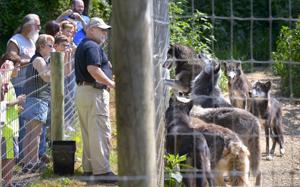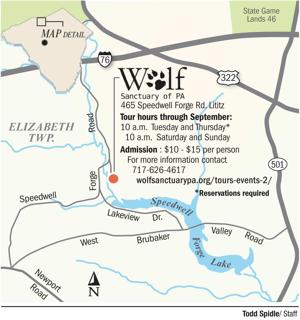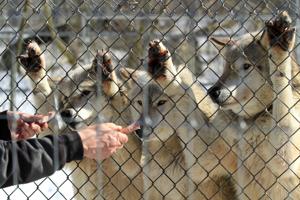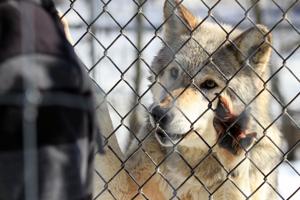Instead, a howling, animal-like sound emerges from him, something he says took him about 2½ years to master. Repeated howls from the guide are, within a minute or two, matched. Howls are coming from every direction now. “To be able to be that close to wolves when they’re howling ... to me that’s remarkable,” Rineer says.
And it’s just a small part of what visitors to the Wolf Sanctuary of PA, at 465 Speedwell Forge Road, Lititz, will experience.
The sanctuary is home to a species that has lived in North America for 7,000 years. It allows rescued wolves a safe home in a natural habitat, where multiple acres of enclosures divide the the 45 resident wolves.
Volunteers lead tours allowing people to see the animals in a setting available almost nowhere else.
As Rineer explained to his 20-person tour on a sunny Thursday morning, the wolves in movies are usually not actually wolves. Instead, they're usually dogs made up to look like wolves.
And so the sanctuary allows people to see wolves in a natural setting to understand better what the animals are like, he says.
Rineer, having worked with the wolves in the sanctuary for about seven years now, gets the animals out by rattling a bucket, a sign most of them now recognize as a chance for treats.“They don’t want to be around you,” he quips, indicating the wolves' desire for the bucket full of raw meats. “They don’t care about you.” Some of the wolves come up to the first of two fences for a snack.
Tour guides walk between the two fences, spending the 60-to-90-minute tours discussing the different areas of wolves, and what their dynamics are like. “Everyone … in the pack has a position,” Rineer says.
In feeding the animals, he explains, the pack’s alpha male will eat first. Others know not to challenge him, he says, though if someone tries, the alpha will put them in their place. Tioga, a gray wolf, has a habit of pushing buttons with his father and the pack’s alpha male, Merlin, Rineer says. But Merlin won’t hesitate to remind him of his position, as wolves live in a hierarchy, he says. The tour wanders around the facility, ending with a climb up a large hill — where good walking shoes are recommended — to visit the last few wolves.
The animals currently sport a lighter, summer coat, but Rineer says the two layers of fur are much greater in the winter. Tours are given throughout the snowy months. They allow people to see the wolves in a more visible habitat with less foliage, and overall the animals are far less lethargic in cold months, he says. Rineer also recommends getting different tour guides each time, because each guide tells of his or her own experiences along with the educational sections.
Mary Kaye McDonald, of Frederick, Maryland, says she’s been to the sanctuary twice now and wants to conquer the winter tour next. McDonald says she loves seeing the interaction between the wolves and the guides. There’s a lot of respect and love there, she says. “You don’t get to see that all the time,” McDonald says. “I love animals. I love seeing the passion of the people who work here.”
And passion is what these volunteers have, what gets them up each day.
Rineer says he has really taken to one of the wolves, Lucas, and his goal is to be able to earn his trust to touch him. “The wolves — you kind of build a relationship (with them),” he adds.
source









No comments:
Post a Comment